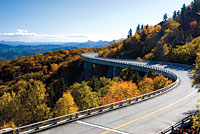Self-described “presentation monkey” and city planner Joe Minicozzi offered members of the public a glimpse of the Asheville Design Center’s latest ideas for an I-26/I-240 bridge during an informal seminar July 9. Two dozen people attended the first showing of Minicozzi’s latest presentation, held at Pack Memorial Library’s Lord Auditorium, on how other cities have spanned their rivers with world-class structures.

Minicozzi said that state transportation departments typically construct slab-and-pillar bridges, similar to the Smoky Park Bridge, unless pushed by citizens who demand something different. He likened the surface decoration sometimes added to such bridges as “putting lipstick on a pig,” and said that other states have often been surprised to discover that more elegant designs can achieve results that are cheaper over time, because innovative engineering can result in lower maintenance costs.
The following day, Linda Figg of Figg Engineering Group offered a presentation to members of ADC and invited community leaders. Figg’s company specializes in bridge design and has garnered three of the five Presidential Awards for bridge design ever awarded by the National Endowment for the Arts. The winning designs are the Sunshine Skyway in Florida, the Natchez Trace Parkway Arches in Tennessee and the Linn Cove Viaduct in North Carolina.
(Completed in 1983 at a cost of almost $10 million, the Linn Cove Viaduct is considered to be the most complicated segmental concrete bridge ever built. The Blue Ridge Parkway’s plans included a section that wound around Grandfather Mountain, through a major wildlife corridor. Planners wanted to keep animals and vehicles out of each other’s way and keep tree cutting to an absolute minimum. The bridge is almost 1,250 feet long and composed of 153 precast segments—no two of which are identical and only one of which is straight.)
Following the ADC meeting, Figg met with Mayor Terry Bellamy, City Manager Gary Jackson and City Council member Brownie Newman. “I hope that we will be able to get their help, or the help of a firm like theirs, to analyze the concepts developed by the Design Center,” Newman said afterwards. “One of the interesting things they pointed out is that these beautiful, elegant bridges do not necessarily cost more to build because they typically require much less construction material. The use of suspension techniques spreads the weight in a manner that requires less overall materials, which also makes them more environmentally friendly.”
The ADC has proposed a simpler, smaller solution to the pending remodel of the I-26 Connector through Asheville. While the state DOT plan calls for nine bridges, the ADC suggests only four, including a double-decker span for the confluence of I-240 and I-26. There are no double-decked bridges in North Carolina at present, according to Minicozzi, and when DOT responded, somewhat skeptically, to the ADC’s design at a June 27 City Council session, their drawing for a double bridge entailed stacking one slab-and-pillar bridge on top of another. Minicozzi’s presentation included the DOT drawings, which depict a massive structure including 20-foot-thick supports beneath the upper span. But photos of other bridges in Minicozzi’s presentation showed double spans from around the world that used less material and create graceful arches and curves.
Moreover, Minicozzi asserted that such bridges can enhance property values in homes and offices that enjoy a view of the structures, as well as become signature pieces for cities, as they have from Charleston to Toledo to San Francisco.



By the time they get this built, there will be 9 more mayors, and they will have paid for the project 7 times over paying consultants that tell the they need a consultant. Kinda like the 19 times they’ve paid consultants to tell them that the civic center is old. Good Ol Asheville, were noting gets done but a whole lot of yappin. Keep yappin City Council, that’s all you ever do.